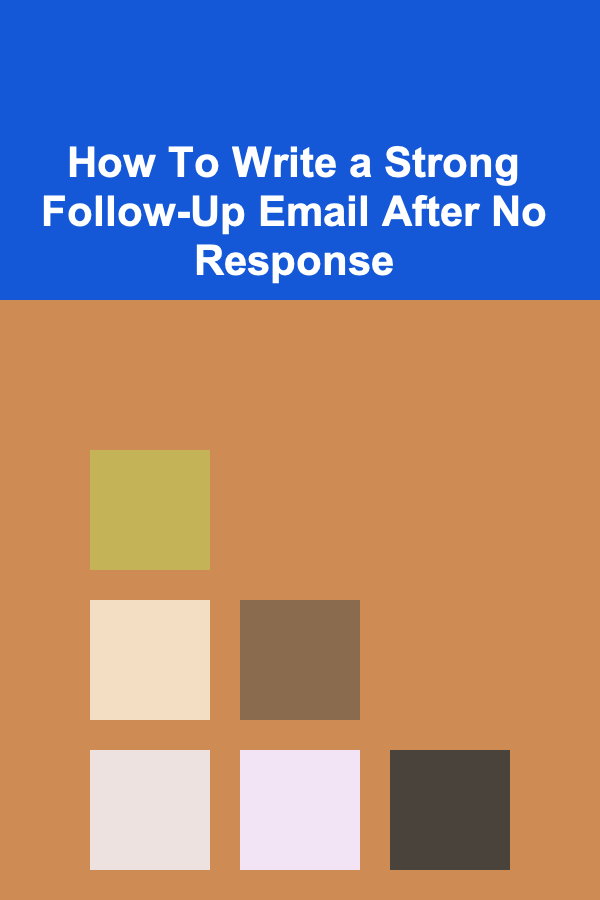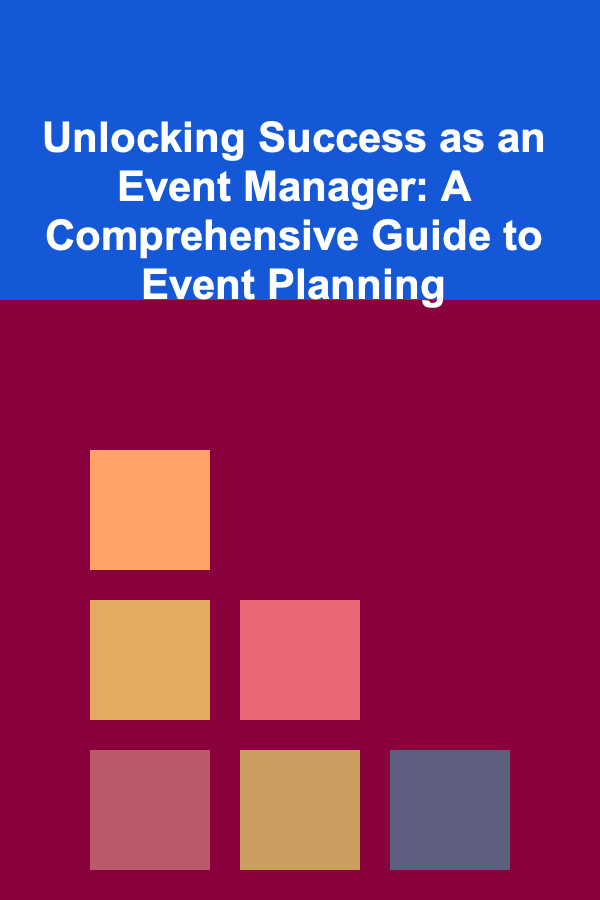
How To Write a Strong Follow-Up Email After No Response
ebook include PDF & Audio bundle (Micro Guide)
$12.99$11.99
Limited Time Offer! Order within the next:

In the fast-paced world of business and personal communication, it's not uncommon for emails to go unanswered. Whether you're trying to land a job, follow up on a business proposal, or simply seeking information, the art of crafting a polite and effective follow-up email is essential. A strong follow-up email can make the difference between getting a response and being overlooked, especially when you're faced with silence after your initial outreach. But how do you write a follow-up email that captures attention without sounding too pushy or desperate? In this article, we will explore the best practices for writing a strong follow-up email after no response, focusing on tone, timing, structure, and content that increases your chances of getting noticed.
The Importance of Follow-Up Emails
A follow-up email is a gentle reminder that you are still waiting for a response, and it shows persistence without being too aggressive. It serves multiple purposes:
- Remind the recipient: People are busy, and emails often get lost in the shuffle. A follow-up serves as a reminder, ensuring your original message doesn't go unnoticed.
- Reaffirm your interest: It shows that you are still interested in continuing the conversation, whether it's about a job opportunity, a business proposal, or something else.
- Open the door for further communication: A follow-up email creates an opportunity to keep the conversation going, especially if the recipient hasn't had time to respond to the initial message.
- Demonstrate professionalism: A well-crafted follow-up email shows that you are courteous, organized, and committed, which are all positive traits in any professional or personal interaction.
Understanding the Reasons for No Response
Before you jump into writing a follow-up email, it's important to understand why you might not have received a response in the first place. There are several potential reasons:
- The recipient is busy: People have packed schedules and might not have gotten around to reading or replying to your email.
- Your email got lost in the inbox: High-volume inboxes can cause important emails to get buried among the flood of others, making it difficult to keep track of every message.
- Your email was overlooked: Even if your email was seen, it may have been forgotten or unintentionally dismissed.
- Lack of urgency: If your email didn't express a sense of urgency or importance, the recipient may not have prioritized responding.
- The recipient has no answer yet: Sometimes, the person you emailed doesn't have the information you're asking for and hasn't had the chance to follow up with you.
- The recipient is not interested: In some cases, there may be no response because the recipient isn't interested or doesn't see value in responding.
Understanding these possibilities can help you approach your follow-up email with empathy and the appropriate tone. A tactful, thoughtful approach is more likely to yield positive results than one that is overly assertive or impatient.
Timing Your Follow-Up
Timing is everything when it comes to following up. Send your follow-up too soon, and you risk coming across as impatient or overzealous. Wait too long, and the recipient might have forgotten about your initial email or moved on to other matters. The ideal timing depends on the context of your original email, but here are some general guidelines:
1. After 3-5 Days:
For a general email, waiting three to five days before sending a follow-up is appropriate. This gives the recipient time to catch up on their inbox and respond, while also providing a reasonable amount of time for them to process the information you shared.
2. After 7-10 Days:
If you've already sent a follow-up email once and haven't received a response, waiting about a week or more before following up again is generally advisable. At this point, your email will likely be getting lost among others, and another follow-up will serve as a reminder that you're still waiting.
3. After Two Weeks or More:
For less time-sensitive matters, such as job applications or proposals, a follow-up after two weeks or longer may be appropriate. This shows that you're patient but still committed and interested.
In any case, be mindful of how often you follow up. Bombarding someone with constant emails can quickly turn off even the most professional contacts. Limit your follow-ups to two or three emails at most before considering a more direct approach, such as picking up the phone or sending a LinkedIn message.
Crafting a Polite and Professional Tone
The tone of your follow-up email is crucial in maintaining a positive relationship with the recipient. The goal is to be polite and respectful while also making your request clear. Here are some tips to strike the right tone:
1. Be Courteous and Respectful
A follow-up email should never feel like an accusation or demand. Acknowledge that the recipient might be busy and express understanding for their time constraints.
Example:
"I completely understand that you're likely swamped with tasks, but I wanted to check in regarding my previous email."
2. Be Positive
Even if you're feeling frustrated by the lack of response, keep the tone positive and optimistic. Avoid showing frustration or making negative assumptions about the recipient's intentions.
Example:
"I hope everything is going well on your end. I just wanted to touch base about my previous email and see if you had any updates."
3. Be Brief
Your follow-up email should be concise and to the point. The recipient likely has many emails to manage, so keep your message short and easy to digest.
Example:
"I wanted to follow up on the email I sent last week regarding [topic]. If you have any further questions or need additional information, please let me know."
4. Show Appreciation
Always express gratitude for the recipient's time, regardless of whether you receive a response or not. This creates goodwill and makes your follow-up feel less demanding.
Example:
"Thank you for taking the time to read my email. I truly appreciate it, and I look forward to hearing back from you."
Structuring Your Follow-Up Email
A well-structured follow-up email is easier to read and more likely to elicit a response. The key is to keep it clear, polite, and to the point. Below is a basic structure for a follow-up email:
1. Subject Line
The subject line should be clear and reflect the purpose of your email. Use the recipient's name if possible to personalize it, and keep it short.
Example:
"Following Up on [Topic] -- [Your Name]"
2. Greeting
Start with a friendly but professional greeting, using the recipient's name if possible.
Example:
"Dear [Recipient's Name],"
3. Polite Introduction
Briefly remind the recipient of your previous email, keeping it light and acknowledging that they may have been busy.
Example:
"I hope you're doing well. I just wanted to follow up on the email I sent last week regarding [topic]."
4. Restate Your Request
Clearly restate what you are requesting or what you need from the recipient. Be polite and concise.
Example:
"I would appreciate it if you could let me know your thoughts on the proposal I sent over or if there is any additional information you need."
5. Call to Action
Invite the recipient to respond by offering a call to action, such as scheduling a meeting, providing feedback, or answering specific questions.
Example:
"Please let me know if you're available for a quick call next week, or if there's anything else you need from me."
6. Polite Closing
Close your email with a polite and appreciative note.
Example:
"Thank you once again for your time. I look forward to hearing from you soon."
7. Sign-Off
Use a professional sign-off like "Best regards" or "Sincerely," followed by your name.
Example:
"Best regards,
[Your Name]"
Avoid Common Mistakes in Follow-Up Emails
While writing a follow-up email, it's important to avoid making common mistakes that could hurt your chances of receiving a response. Here are some things to watch out for:
1. Being Too Aggressive
Avoid demanding a response or coming across as overly insistent. A good follow-up email should gently nudge the recipient, not pressure them.
2. Being Too Casual
While it's important to sound friendly, avoid being too informal or using slang. Your follow-up email should remain professional, especially in a business context.
3. Writing Long and Complex Emails
Long emails are easy to overlook. Make your follow-up concise and clear. Avoid unnecessary details, and focus on the main message.
4. Sending Multiple Follow-Ups Too Quickly
Give the recipient enough time to respond before sending another follow-up. Bombarding them with emails can create a negative impression.
5. Failing to Include a Clear Call to Action
Without a clear request or next step, your email may go unnoticed or be left unanswered. Always include a specific call to action that encourages a response.
Conclusion
Writing a strong follow-up email after no response is a skill that can be honed with practice. By understanding the reasons behind no response, timing your follow-up appropriately, and maintaining a polite and professional tone, you can greatly improve your chances of getting a response. Remember, your follow-up email should be brief, clear, and considerate, with a focus on encouraging further communication. Keep it respectful, stay patient, and always express gratitude for the recipient's time. With the right approach, your follow-up emails can lead to valuable conversations, opportunities, and results.

How to Become a Personal Shopper for Hong Kong Products from Home
Read More
How to Choose Between Wired and Wireless Home Security Systems
Read More
How to Clean Your Bathroom Without Harsh Chemicals
Read More
How to Clean Your Home While Keeping Your Pets Safe
Read More
How to Manage Debt While Saving for the Future
Read More
Unlocking Success as an Event Manager: A Comprehensive Guide to Event Planning
Read MoreOther Products

How to Become a Personal Shopper for Hong Kong Products from Home
Read More
How to Choose Between Wired and Wireless Home Security Systems
Read More
How to Clean Your Bathroom Without Harsh Chemicals
Read More
How to Clean Your Home While Keeping Your Pets Safe
Read More
How to Manage Debt While Saving for the Future
Read More